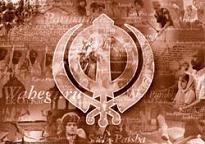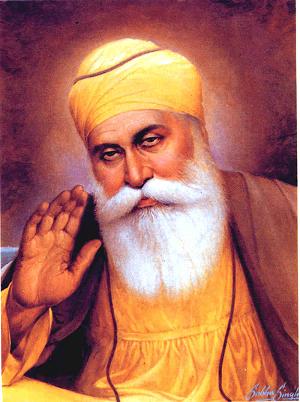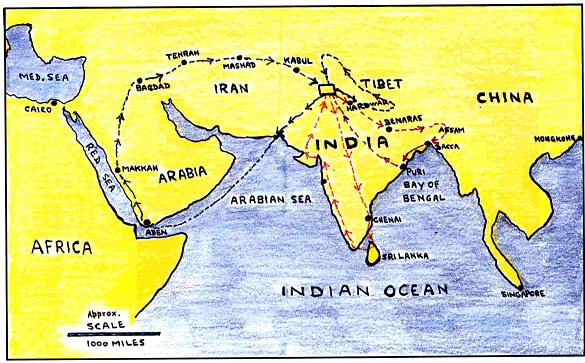
 |
Sikh Missionary Society
U.K. (Regd)
10,
Featherstone Road.
Southall, Middx, U.K. UB2 5AA
Tel: +44
020 8574
1902
Fax: +44
020 8574
1912
Reg
Charity No: 262404
|
||
|---|---|---|---|
|
|
|||
The Founder of The Sikh Faith
The Sikh & The Guru
Guru Nanak
The Divine Call
The Four Great Journeys
The Three Principles
The two words ‘SIKH’ and ‘GURU’ are inter/related having their origin in the ancient indigenous language of Panjab. Literally, ‘sikh’ means a learner or a student, whereas ‘guru’ is a teacher or a guide.
In modern days and times the word Sikh has become more specific as a proper noun, referring to a member of the Sikh religious community which has established itself in the last five hundred years or so.
On the contrary, the word ‘guru’ has become more general as a common noun, referring to any expert in any specialist field, e.g. education, economics, religion or politics. However, when the Sikhs use the word Guru, it refers specifically to the ten spiritual masters of their faith led by Guru Nanak.
The Sikhs believe that the GURU is the revealer of the TRUTH, and leads a Sikh out of darkness, as he follows the Guru’s light seeking the truth. The aim of a Sikh is to gain wisdom, understand him/her and his/her relationship with God. In order to achieve this aim a Sikh seeks the guidance and blessing of the Guru.
Guru Nanak, the founder of Sikhism, was born in 1469 in the village of Talwandi near Lahore in Panjab. The place is now called Nankana Sahib and is in Pakistan.
Nanak was born to a Hindu family, but he soon revolted against the religious trappings, paraphernalia and the caste-system of Hinduism. He was equally unhappy about the way some Muslim preachers or Mullahs preached intolerance and fanaticism in the name of religion, which often led to bloodshed, tyranny and oppression of those who did not accept Islam. He condemned rampant corruption and exploitation, which was a common feature of both ruling Muslims and the Hindu priestly class.
He declared himself as belonging to neither Hindus nor Muslims but the whole human race, and as God’s servant he had come to deliver His Message, which he called ‘Dhur Ki Baani’.
At the age of thirty-seven, Guru Nanak thus started on his ‘four great journeys’ all on foot, to convey ‘HIS MESSAGE’ from village to village, town to town in the true traditions of the ‘great men’ before him, e.g. the Buddha, Jesus Christ, and the Prophet Mohammed.
In his preaching Guru Nanak suggested practical ways of countering selfishness, ignorance and all that is evil. The spiritual and social welfare of the common people was his prime concern. He wanted them to act with reason and not follow others blindly.
According to Guru Nanak the political and cultural domination of the people by the ruling and priestly classes was chiefly responsible for their degeneration and degradation. He gave these demoralised people a new consciousness, which was based on the principle of the ‘unity’ and ‘fatherhood’ of God and the equality and kinship of humankind.
Guru Nanak’s teachings were a direct challenge to the authority of the priestly class and the inhumanity of the ruling tyrants. There were times when he was ridiculed, stoned and even imprisoned, however, Guru Nanak was never afraid to raise his clear voice against cruelty, injustice and falsehood.
The people, to whom Guru Nanak talked and preached found something special and different in his message from what they already knew; and those who followed him or his teachings closely, came to be known as Sikhs, meaning learners or followers. Both Hindus and Muslims were among Guru Nanak’s followers.
These followers or Sikhs called him the true Guru. He was, indeed, the prophet of the people. He lived amongst them, shared their joys and sorrows and taught them the way of honest and truthful living. His main message was:
“Truth is high. But higher still is truthful living. ”
Guru Nanak stressed that one should not try to
escape from worldly family responsibilities but embrace them.
“Not the ascetic way,
But a life of truth and love
Amid the world’s temptations
Is the secret of spiritual life”?
He also advised to desist from bigotry and respect the saints of every faith’.
“Put away thy pride.
The essence of religion is humility,
Service, sympathy.
Not the yogi’s garb and ashes,
Not the shaven head,
Not long prayers’
Not recitations and torturings......”
Guru Nanak died in 1539. Before his death, he had
ordained his successor. Guru Angad, who would carry forward his message
as compiled in a Pothi (a notebook of Guru’s teachings). This pothi
later became the basics of a larger collection of teachings by the
successive Gurus to form the Sikh holy book called the Guru Granth
Sahib.
One day, when Guru Nanak was about 37 years old, he went to the near by river VAYEN to bathe and meditate as usual. But this time, something happened which was very unusual. Nanak was so engrossed with his love for God that he found himself in communion with Him. Some people, who had noticed Nanak dipping in the water, did not see him come out of the river. His clothes were still left on the bank and the people became very concerned. No one could establish Nanak’s whereabouts; most thought that he had been carried away by a strong current and was probably dead. However, some people such as his friend Mardana started a twenty-four-hour vigil as they had complete faith that Nanak was alive, and faith in his mysterious ways.
Two nights passed. On the third day, to the pleasure and amazement of people near the river, Nanak was seen walking out of the water almost at the same spot where he had disappeared two days earlier. Soon people gathered around him and asked questions. He only pointed his finger to the skies and remained silent. This did not stop the crowd getting bigger and questions getting more persistent.
At last he spoke: ”I have received a call from the AKAL PURKH (The Timeless Being). God has favoured me with a task to go and spread His message to all people far and near. ‘THERE IS NO HINDU, NO MUSLIM’. God does not see any difference between a Hindu and a Muslim. Nor does He belong to only Hindus or Muslims. He considers all people alike and equal. This is true, and this is His message.
Nanak’s sermons became the talk of the town. A local Qazi complained about him to the governor, and he was summoned to explain himself. Before the hearing and the consequent judgement Nanak stood with his critics in the mosque where the Qazi led the prayer. As soon as they all finished the prayer Nanak was seen cheerful and smiling. The Qazi was rather angry and irritated by Nanak’s behaviour. But soon Nanak explained and said,
“We are here in the house of the God. He witnesses every thing and knows every thing. Both the Qazi and the Governor’s minds were wandering away during the prayer. One was thinking of newborn filly, and the other about his business of buying horses in Kabul. Both are not good Muslims.”
Of course what Nanak had said about the lack of concentration by the two men in their prayer was true. Everyone who heard Nanak say these words was amazed. All, including the Qazi and the Governor were convinced that Nanak was indeed a divine being.
After this, Nanak resigned from the job as a storekeeper and made plans to embark on his mission with the message of truth, love and honesty. He left his home and toured various towns in Panjab. As Nanak was very fond of music and liked to sing his messages he asked Mardana who was a RABAB player to accompany him. One of his well-known visits included Saidpur (Eminabad) where he stayed at the house of a poor carpenter named Lalo, and had an encounter with a local rich landlord named Malik Bhago. The story describing this incident is given later in this book.
“As fragrance dwells in a flower,
And reflection in a mirror,
So does God dwell in every soul;
Seek Him therefore in Thyself ”
Guru Nanak
|
GURU NANAK (1469 - 1539)
“Among the low let my caste be the meanest, of the lowly, let me the lowliest be. O Nanak! Let such be the men I know, With such men let me keep company. Why should I try to emulate the great? Where the fallen have protected been Is your grade and your goodness seen.” |
 |
Guru Nanak
A rough sketch of Guru Nanak’s four great journeys.

After Nanak had spent some time spreading the Divine Message amongst the people in the Panjab he planned to venture further out with his mission. This adventurous spirit was equally complemented with his inquisitiveness and desire to visit some important centres of religious worship and learning, as well as meeting people and sharing their joys and sufferings. For nearly fifteen years Nanak was on the move criss crossing the whole of Indian subcontinent, east, west, north and south. These long tours, purposeful wanderings or journeys were popularly known as UDASIS (like Odysses). Four Udasis were under taken as four different itineraries; each starting on foot from his hometown in the Panjab, and taking some years to complete. During each journey, Nanak usually wore a strange ‘motley’ dress, which attracted people’s attention and curiosity.
1. Guru Nanak’s 1st journey was towards east and lasted for about three years (1507-1510). Mardana accompanied him. During this tour he visited some important centres of the Hindu religion, and attended their festive occasions. Some of these places were KURKSHETRA (attending the occasion of solar eclipse), HARDWAR on the GANGES, BENARAS (where he exchanged views with a leading Hindu Pandit), GAYA and PATNA (centres of Buddhist and Hindu worship). Then he reached KAMROOP (Assam) where he had encounters with enchanting women and magic. Returning through DACCA and CUTTOCK he visited the famous temples of JAGANNATH at PURI on the sea coast From there his journey passed through central India where he also met some aborigines who were living the life of cannibalism, and persuaded them to better their ways. After reaching Panjab he rested for a while before starting again on his second journey.
2. Guru Nanak’s 2nd Journey lasted about four years (1511-1514). This tour was towards the south of India reaching Sri Lanka. Two ‘Jats’ (farmers) Saida and Gheo expressed their enthusiasm to accompany him. The Guru was pleased to accept their request. This itinerary left behind a legacy of a long line of Gurdwaras down to the JAFFNA where Raja Sivnabh showed great interest in Nanak’s teachings. The return journey to Panjab was made along the Western side of the South Indian Peninsula, and then further northwards through the provinces of Gujarat and Sindh.
3. Guru Nanak’s 3rd Journey took him to a northerly direction and lasted about two years (1515-1516). This time he was accompanied by Hassu, a black smith, and Sihan a washerman. The region travelled was generally mountainous, and his strange dress was mainly composed of skins and woollies. He walked through Nepal reaching western Tibet and met some famous Yogies or hermits living in caves. His return journey was through LADAKH, SRINAGAR, JAMMU and SIALKOT.
4. Guru Nanak’s 4th Journey to the west was the longest and lasted for over four years (1517-1521). This time he covered a part of his journey by boat through the Arabian Sea to reach MAKKAH, the most sacred place of the Muslims in Arabia. From there he travelled northwards to MADEENA, and onwards to BAGDAD in Iraq (the only country in the Arab world where a Gurdwara commemorates his presence). He continued his return journey through TEHRAN, MASHAD, and KABUL before reaching Panjab.
Everywhere the Guru spent a few weeks or months, he left a legacy of Gurdwaras named after his visit. He certainly proved to be the greatest traveller on foot of his time covering thousands of miles on each journey.
Guru Nanak’s message of Truthful Living may be summed up in three basic principles, which he laid down for his Sikhs. They are:
KIRAT KARNA (Working in earnest)
NAAM JAPPNA (Remembering God)
WAND CHHAKHNA (Sharing food)
KIRAT KARNA means earning one’s livelihood by honest means by applying one’s self sincerely to work. This principle teaches that every human being has a potential for earning enough for a reasonable living. It is not good to be a burden on others or living on charity or grants. Exploitation of labour is equally bad. In a country like India where a visitor comes across so many beggars, wandering ‘Sadhus’ and so called holy men living on other people’s charity, Sikhs were particularly advised by the Guru’s not to do so. According to Nanak
“One who delivers Sermons but begs alms door to door
Is blind of mind and devoid of self respect.”
NAAM JAPPNA means reciting or meditating in the name of God, and thanking Him for the gift of life and living. The Guru’s advice to his Sikhs is
“Remember God all the time and help others to recite His name.”
This art of meditating in God’s name is called SIMRAN. But the Sikhs are also warned of the futility of any such exercise or meditation with an empty stomach.
“Rosary is no help to the hungry devotee”
It is difficult for an ordinary person to concentrate on God’s name when the stomach is empty and rumbling all the time. Not eating enough, leads to a weak body and in turn to a weak mind. That is why Sikhs have been advised by their Guru to work to eat, and eat to pray. The order is simple and sensible.
WAND CHHAKHNA literally means sharing your meal with the one without. This principle is based on the Sikh belief that one must do something for the benefit of the less fortunate members of the community. The Gurus had advised Sikhs to practice ‘DASVANDH’ i.e. sparing 10% of the earnings for charitable causes. In the Sikh ideology ‘creating wealth’ is not a bad thing provided the benefits are shared with the needy.
“He alone treads the path of righteousness
Who earneth his bread with hard labour
And shareth it with others, sayeth Nanak”
While at Kartarpur Guru Nanak himself demonstrated to his followers the working of the above three principles of truthful living in improving the individual, as well as the whole community. He set up a small commune where he was able to blend all the three as a matter of example and future practice. It was here that the institution of LANGAR (free kitchen) was established on a firm footing.
Central to the principle of truthful living is the concept of SEVA (selfless service). This service or SEVA is recognised in either of the three ways i.e. TANN, MANN and DHANN.
‘TANN’ means body; service or help which involves a personal physical effort to do some job or work for non- personal benefits e.g. helping to cook or clean in the langar.
‘DHANN’ means money; service or any other work which involves help in the form of cash or kind,
e.g. bags of flour, milk, butter vegetables etc. for running the langar (free kitchen for all).
‘MANN’ means mind; one must remember that just as words without actions have no value, similarly any service without sincerity of mind has no merit.
| Previous Chapter - Chapter 1 : General Introduction |
Next Chapter - Chapter 3 : Guru Nanak’s Successors
|